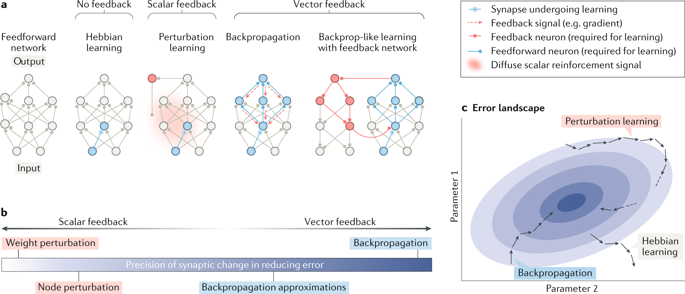当前位置:
X-MOL 学术
›
Nat. Rev. Neurosci.
›
论文详情
Our official English website, www.x-mol.net, welcomes your feedback! (Note: you will need to create a separate account there.)
Backpropagation and the brain.
Nature Reviews Neuroscience ( IF 34.7 ) Pub Date : 2020-04-17 , DOI: 10.1038/s41583-020-0277-3 Timothy P Lillicrap 1, 2 , Adam Santoro 1 , Luke Marris 1 , Colin J Akerman 3 , Geoffrey Hinton 4, 5
Nature Reviews Neuroscience ( IF 34.7 ) Pub Date : 2020-04-17 , DOI: 10.1038/s41583-020-0277-3 Timothy P Lillicrap 1, 2 , Adam Santoro 1 , Luke Marris 1 , Colin J Akerman 3 , Geoffrey Hinton 4, 5
Affiliation

|
During learning, the brain modifies synapses to improve behaviour. In the cortex, synapses are embedded within multilayered networks, making it difficult to determine the effect of an individual synaptic modification on the behaviour of the system. The backpropagation algorithm solves this problem in deep artificial neural networks, but historically it has been viewed as biologically problematic. Nonetheless, recent developments in neuroscience and the successes of artificial neural networks have reinvigorated interest in whether backpropagation offers insights for understanding learning in the cortex. The backpropagation algorithm learns quickly by computing synaptic updates using feedback connections to deliver error signals. Although feedback connections are ubiquitous in the cortex, it is difficult to see how they could deliver the error signals required by strict formulations of backpropagation. Here we build on past and recent developments to argue that feedback connections may instead induce neural activities whose differences can be used to locally approximate these signals and hence drive effective learning in deep networks in the brain.
中文翻译:

反向传播和大脑。
在学习过程中,大脑会修改突触以改善行为。在皮层中,突触被嵌入多层网络中,这使得很难确定单个突触修饰对系统行为的影响。反向传播算法在深度人工神经网络中解决了此问题,但历史上一直将其视为生物学问题。尽管如此,神经科学的最新发展和人工神经网络的成功激发了人们对反向传播是否提供理解皮质学习的见解的兴趣。反向传播算法通过使用反馈连接传递错误信号来计算突触更新,从而快速学习。尽管反馈连接在皮质中无处不在,很难看到它们如何传递严格的反向传播公式所要求的误差信号。在这里,我们以过去和最近的发展为基础,认为反馈连接可能会引发神经活动,其差异可用于局部近似这些信号,从而推动大脑深层网络的有效学习。
更新日期:2020-04-24
中文翻译:

反向传播和大脑。
在学习过程中,大脑会修改突触以改善行为。在皮层中,突触被嵌入多层网络中,这使得很难确定单个突触修饰对系统行为的影响。反向传播算法在深度人工神经网络中解决了此问题,但历史上一直将其视为生物学问题。尽管如此,神经科学的最新发展和人工神经网络的成功激发了人们对反向传播是否提供理解皮质学习的见解的兴趣。反向传播算法通过使用反馈连接传递错误信号来计算突触更新,从而快速学习。尽管反馈连接在皮质中无处不在,很难看到它们如何传递严格的反向传播公式所要求的误差信号。在这里,我们以过去和最近的发展为基础,认为反馈连接可能会引发神经活动,其差异可用于局部近似这些信号,从而推动大脑深层网络的有效学习。

























 京公网安备 11010802027423号
京公网安备 11010802027423号